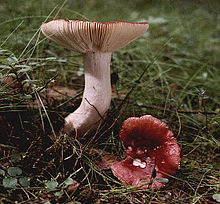Russulales
| Russulales | |
|---|---|
 |
|
| Russula emetica | |
| Scientific classification | |
| Kingdom: | Fungi |
| Division: | Basidiomycota |
| Class: | Agaricomycetes |
| Order: |
Russulales Kreisel ex P.M.Kirk, P.F.Cannon & J.C.David (2001) |
| Families | |
|
Albatrellaceae |
|
| Synonyms | |
|
|
Albatrellaceae
Amylostereaceae
Auriscalpiaceae
Bondarzewiaceae
Echinodontiaceae
Hericiaceae
Hybogasteraceae
Lachnocladiaceae
Peniophoraceae
Russulaceae
Gloeocystidiellaceae
Stereaceae
The Russulales are an order of the Agaricomycetes, (which include the agaric genera Russula and Lactarius and their polyporoid and corticioid relatives). According to the Dictionary of the Fungi (10th edition, 2008), the order consists of 12 families, 80 genera, and 1767 species. According to Species Fungorum (January 2016), the order contains 13 families, 117 genera (16 not assigned to a family), and 3,060 species.
Russuloid agarics represent an independent evolutionary line of agarics, not directly related to the Agaricales.
This group also includes a number of russuloid hypogeous fungi, polypores such as Bondarzewia, some tooth fungi (e.g. Auriscalpium vulgare), and club fungi e.g. Artomyces.Basidiospores in this group are typically ornamented with amyloid warts or but a few exceptions are known, e.g. Heterobasidion annosum. The genus Clavicorona was often treated in the Russulales, but its type species, C. taxophila is in the Agaricales. The remaining species are retained in the Russulales in the genus Artomyces.
...
Wikipedia
